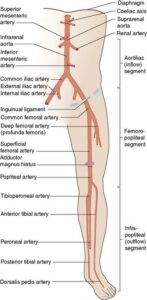B. Left common iliac artery – Explanation
The answer here is left common iliac artery. Femoral artery and deep femoral artery is
less likely as the pain would start below the inguinal ligament. The external iliac artery
becomes the femoral artery after it passes under the inguinal ligament. Hence the
occlusion would be above the inguinal ligament.
If it was a femoro-popliteal artery occlusion, the pain would be described below the
knee.
The option of aortoiliac artery occlusion is not specific as it does not state if it is right or
left. It would also have symptoms of claudication and pain of the buttocks and thighs.
Symptoms of erectile dysfunction can also be seen in aortoiliac artery occlusion. The
ideal answer would actually be an external iliac artery occlusion as there are no
symptoms of gluteal pain in the stem. The common iliac bifurcates into internal and
external iliac arteries and since there is no mention of symptoms of internal iliac artery
obstruction in the stem, an external iliac artery occlusion would actually be the best
option if it was given in the exam. However, since it is not an option given, common
iliac artery occlusion falls into first place as the answer.
Remember, symptoms of occlusion has to occur distal to the level of the occlusion.
less likely as the pain would start below the inguinal ligament. The external iliac artery
becomes the femoral artery after it passes under the inguinal ligament. Hence the
occlusion would be above the inguinal ligament.
If it was a femoro-popliteal artery occlusion, the pain would be described below the
knee.
The option of aortoiliac artery occlusion is not specific as it does not state if it is right or
left. It would also have symptoms of claudication and pain of the buttocks and thighs.
Symptoms of erectile dysfunction can also be seen in aortoiliac artery occlusion. The
ideal answer would actually be an external iliac artery occlusion as there are no
symptoms of gluteal pain in the stem. The common iliac bifurcates into internal and
external iliac arteries and since there is no mention of symptoms of internal iliac artery
obstruction in the stem, an external iliac artery occlusion would actually be the best
option if it was given in the exam. However, since it is not an option given, common
iliac artery occlusion falls into first place as the answer.
Remember, symptoms of occlusion has to occur distal to the level of the occlusion.
LOWER LIMB ARTERIES

